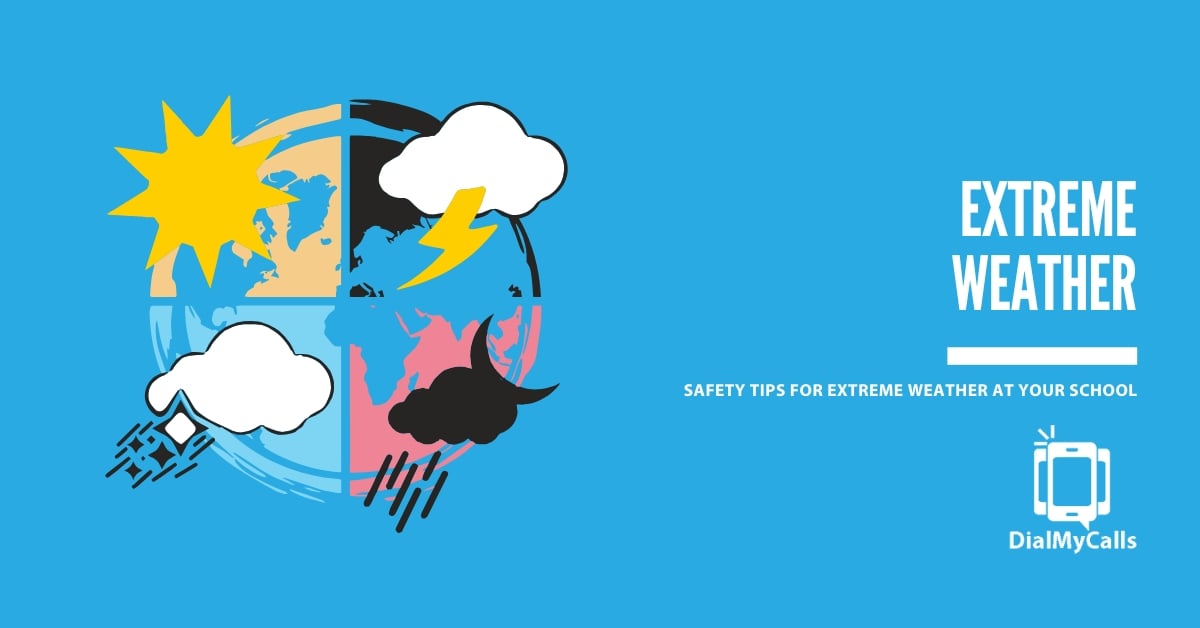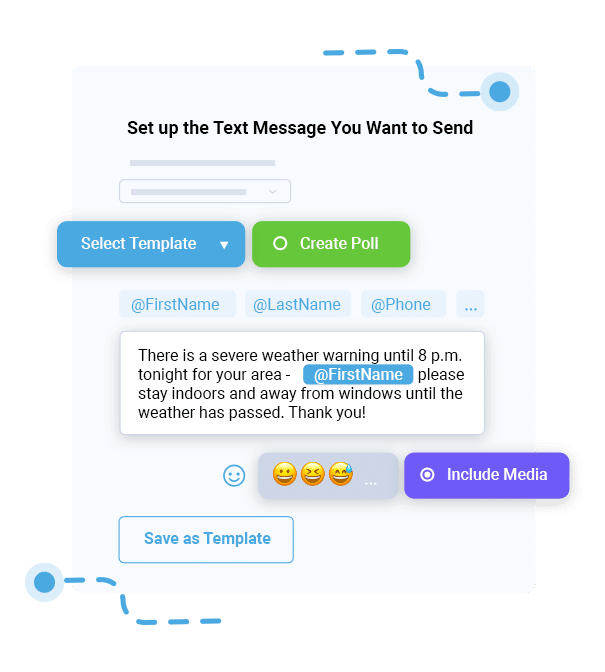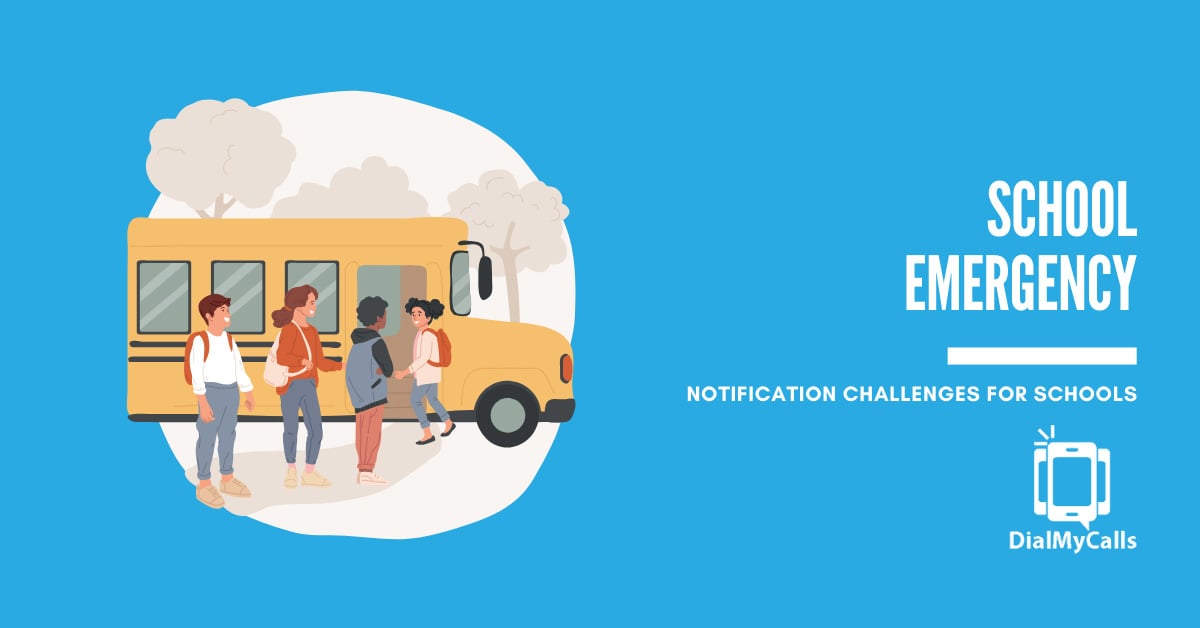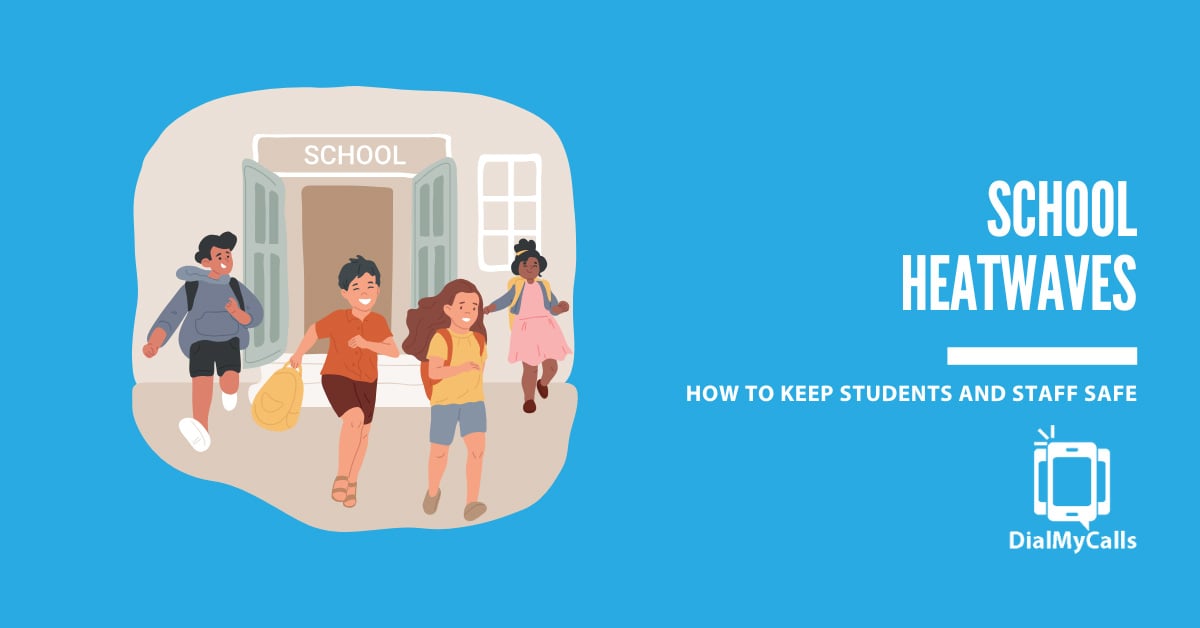Top 5 Safety Tips for Extreme Weather at Your School

Let’s face it—extreme weather is unpredictable, and when it strikes, schools are often caught in the middle of the chaos. As a school administrator, you have a lot on your plate already, but ensuring the safety of students and staff during weather emergencies is non-negotiable. Tornadoes, blizzards, and sudden thunderstorms don’t wait for your approval—they show up unannounced, and you need a plan.
But you don’t need to stress over it anymore. With the right preparation and a proactive approach, you can turn potential chaos into calm. Think of it this way: every drill, every alert, and every step you take today can save lives tomorrow. Wondering how? In this blog, I will share five safety tips that will turn a potential “Uh-oh” moment into a “We’ve got this.”
5 Key Safety Tips for Schools to Manage Extreme Weather Conditions
- Monitor Weather Conditions Early & Be Proactive
- Use Mass Notification Systems
- Establish and Clearly Mark Safety Zones
- Activate Your Emergency Plan Promptly
- Train Staff to Handle Emergency Situations
Keep Everyone Connected & Informed
Get the Word Out Quickly with Bulk Texting and Voice Calls
Monitor Weather Conditions Early & Be Proactive
When it comes to extreme weather, knowledge is your best defense. Staying one step ahead of sudden weather changes means proactively monitoring the weather. Make it a habit to check reliable weather sources like local news channels, weather apps, or NOAA (National Oceanic and Atmospheric Administration) radios.
Additionally, you can also use apps that provide instant, real-time weather information. Apps like AccuWeather, Weather Underground, or even Google Weather can give real-time updates, helping you plan ahead.
Pro Tip: Opt for apps with radar features, so that you can visualize storms in real-time and anticipate their impact on your location.
Let me put this in perspective with an example:
Suppose your school is in an area prone to winter storms. By closely monitoring updates, you’ll know when to prepare for icy conditions and potential closures, giving you enough time to inform staff and parents.
Use Mass Notification Systems
Once you’re aware of the weather situation, effective communication becomes essential. A dependable mass notification system can instantly alert everyone in your school community. For example, DialMyCalls’ mass notification system allows you to send mass texts, automated voice calls, or emails, ensuring that no one misses crucial updates.
Here’s what makes such systems so effective:
- Multi-Channel Communication: Alerts can be sent via text and email simultaneously to ensure no one misses the message.
- Pre-Scheduled Alerts: If you’re aware of potential bad weather (like an incoming hurricane), you can pre-schedule reminders or updates.
- Customizable Templates: The systems allow you to save templates for common scenarios, like snow days or early closures, saving time during high-pressure situations.
Real-Life Example of Impact:
Take the case of a school in the Midwest that faced an unexpected tornado warning. The principal used a mass notification system to send out an alert to all parents and staff, advising them to stay put and follow shelter-in-place protocols.
Because of the instant and clear communication, parents knew their children were safe, and staff could focus on managing students without fielding constant phone calls.
Instant Communication, Whenever You Need It
Send Real-Time SMS & Voice Call Alerts from Anywhere
Establish and Clearly Mark Safety Zones
- Identify the Safest Locations
- Clearly Mark These Zones
- Conduct Regular Safety Drills
- Stock Safety Zones with Essentials
- Customize Safety Zones for Special Needs
- Communicate the Plan to Everyone
When extreme weather strikes, knowing where to go can mean the difference between staying safe and putting lives at risk. That’s why identifying, establishing, and clearly marking safety zones in your school is one of the most critical steps in your emergency preparedness plan.
These designated areas are where students, faculty, and staff should head to for protection when faced with severe weather events like tornadoes, hurricanes, or extreme storms.
Here’s my take on how you can create effective safety zones in your school:
Identify the Safest Locations
The first step is pinpointing areas in your building that can withstand extreme weather conditions. For tornadoes, this could mean windowless rooms, basements, or interior hallways far from glass doors or windows. In areas prone to hurricanes or high winds, reinforced rooms with minimal exterior exposure work best.
It’s crucial to consult local emergency management experts or structural engineers to assess your school’s layout. They can guide you in selecting the most secure areas, ensuring your safety zones are truly effective.
Clearly Mark These Zones
Once you’ve identified your safety zones, make sure they are easy to find—even in stressful situations. Use bright, clear signage with universally recognized symbols and bold text like “Safety Zone” or “Storm Shelter.” Place these signs at eye level and at every entry point leading to the zone.
Additionally, include a map of the safety zones in hallways, classrooms, and staff rooms. This way, everyone can familiarize themselves with the locations during non-emergency times.
Conduct Regular Safety Drills
It’s not enough to mark safety zones—you need to ensure everyone knows how to get to them quickly and efficiently. Conduct regular drills tailored to different extreme weather scenarios. For example:
- Tornado Drills: Practice moving students to the safety zones in an orderly manner within a set time.
- Hurricane Drills: Simulate sheltering in place and managing extended stays in safety zones.
- Thunderstorm Drills: Teach students to avoid outdoor spaces and move indoors quickly.
Drills help minimize panic during a real emergency by turning the process into second nature for everyone involved.
Stock Safety Zones with Essentials
Your safety zones should be more than just a space—they should be equipped to handle emergencies. Consider stocking these areas with first aid kits, flashlights and batteries, communication devices, and snacks and water.
Customize Safety Zones for Special Needs
Remember to accommodate students and staff with special needs when planning safety zones. This includes wheelchair accessibility, extra supplies for medical conditions, and having trained staff available to assist during emergencies. Assign specific roles to ensure no one is overlooked in the rush to safety.
Communicate the Plan to Everyone
Finally, make sure all staff, students, and even parents know about the safety zones and their purpose. Share maps and instructions during orientations, staff meetings, or through newsletters. The more informed everyone is, the smoother the process will be during an actual emergency.
Activate Your Emergency Plan Promptly
Timing is everything in an emergency. Your school should have an emergency action plan tailored to different weather scenarios. Make sure staff know when and how to activate it, whether it involves evacuating, sheltering in place, or delaying school dismissal.
I say this because not all weather events will require the same level of response. For example, a tornado warning calls for immediate sheltering in safety zones, while a severe thunderstorm might only require moving students indoors from the playground. So, train your staff to recognize the severity of different weather alerts and activate the plan accordingly.
Additional Tip: Post a copy of the emergency action plan in key locations around the school, such as the staff lounge, main office, and classrooms, so it’s always accessible.
3 Pro Tips! |
|---|
| Communicate Clearly and Quickly When it’s time to activate your plan, clear communication is essential. Use a mass notification system, such as DialMyCalls, to alert staff, parents, and students of the situation and the steps being taken. Clear, concise messaging helps reduce panic and ensures everyone knows what to do. Example: During a sudden snowstorm, your notification might look like this: “Due to worsening weather conditions, we are activating our emergency plan. Students are being moved to safety zones. Please avoid picking up your child until further notice. We will keep you updated.” Be Ready to Shelter in Place or Evacuate Depending on the type of weather emergency, your plan might involve sheltering in place or evacuating the building. Here’s how to decide: Shelter in Place: For events like tornadoes, hurricanes, or lightning storms, moving everyone to interior safety zones is the safest option. Evacuate: In rare cases, such as a building becoming unsafe due to flooding, you may need to evacuate. Have a clear plan for safe exits and transportation to an alternate location. Factor in Timing Sometimes, activating your emergency plan means making the tough call to delay dismissal or keep students indoors. Severe weather doesn’t always respect school hours, so flexibility is key. If extreme weather hits near the end of the school day, it’s safer to delay student departure than to risk sending them into hazardous conditions. Example: Imagine a severe thunderstorm begins at 3:00 PM, just as students are preparing to head home. Instead of rushing dismissal, you keep students indoors and activate your communication system to inform parents of the delay. Once the storm passes, students are dismissed safely, and panic is avoided. |
Train Staff to Handle Emergency Situations
Your emergency plan is only as strong as the people executing it. When extreme weather strikes, every second counts, and your staff must be prepared to act quickly, calmly, and confidently. Training your team ensures that everyone knows their role, understands the protocols, and can work together seamlessly to keep students safe.
How to Implement Training
- Start with a Workshop
- Incorporate Ongoing Practice
- Use Role-Playing Scenarios
- Provide Resources
Start with a Workshop
Begin the school year with a hands-on workshop led by safety experts or local emergency services. This sets a solid foundation for the year and allows staff to ask questions. Also train them on how to use mass notification systems in case of an emergency.
Incorporate Ongoing Practice
Schedule quarterly drills to keep procedures fresh in everyone’s minds. Use these drills to test different aspects of the plan and improve weak points.
Use Role-Playing Scenarios
Role-playing exercises can simulate real emergencies, helping staff build confidence in their abilities. For example, assign roles like “injured student” or “panicked parent” during a drill to add realism.
Provide Resources
Ensure staff have easy access to training materials, such as printed emergency guides, online tutorials, or quick-reference charts.
Conclusion
Extreme weather doesn’t have to catch your school off guard. By staying proactive, communicating effectively, and prioritizing safety drills, you can create a safe haven for your students and staff, no matter what Mother Nature throws your way.
Remember, tools like DialMyCalls can make communication during emergencies smoother and more efficient. If you are ready to take that extra step today and prepare your school for tomorrow’s uncertainties, get in touch with us today!
Stay Connected with Mass Notifications
Create & Send a Broadcast to Thousands in Seconds
Author
Tim Smith is the Media Manager at DialMyCalls, where he has leveraged his expertise in telecommunications, SaaS, SEO optimization, technical writing, and mass communication systems since 2011. Tim is a seasoned professional with over 12 years at DialMyCalls and 15+ years of online writing experience.
Try Using DialMyCalls Right Now
Start For Free
Recent Posts
- Essential SMS Alert Checklist for Parades, Rallies & Local Events
- How to Send Effective Shelter & Evacuation Text Alerts During Emergencies
- A Step-by-Step Guide to Building a Crisis Communication Playbook
- 6 Top Emergency Notification Challenges Schools Face and How to Solve Them
- 7 Best Practices for Tornado and Severe Storm Emergency Notifications
Categories
“I am a youth minister and have spent hours in the past calling students individually to remind them of an upcoming event or to get out an urgent announcement. With DialMyCalls.com, I cut that time down to about 1 minute. I also love how I can see exactly who answered live and how long they listened so I know if they heard the whole message. DialMyCalls.com is the best website I have stumbled upon all year! Thanks!”
Central Baptist Church
Try Using DialMyCalls Right Now
Start For Free
Author
Tim Smith is the Media Manager at DialMyCalls, where he has leveraged his expertise in telecommunications, SaaS, SEO optimization, technical writing, and mass communication systems since 2011. Tim is a seasoned professional with over 12 years at DialMyCalls and 15+ years of online writing experience.
Try Using DialMyCalls Right Now
Start For Free
Recent Posts
- Essential SMS Alert Checklist for Parades, Rallies & Local Events
- How to Send Effective Shelter & Evacuation Text Alerts During Emergencies
- A Step-by-Step Guide to Building a Crisis Communication Playbook
- 6 Top Emergency Notification Challenges Schools Face and How to Solve Them
- 7 Best Practices for Tornado and Severe Storm Emergency Notifications
Categories
“I am a youth minister and have spent hours in the past calling students individually to remind them of an upcoming event or to get out an urgent announcement. With DialMyCalls.com, I cut that time down to about 1 minute. I also love how I can see exactly who answered live and how long they listened so I know if they heard the whole message. DialMyCalls.com is the best website I have stumbled upon all year! Thanks!”
Central Baptist Church
Try Using DialMyCalls Right Now
Start For Free




